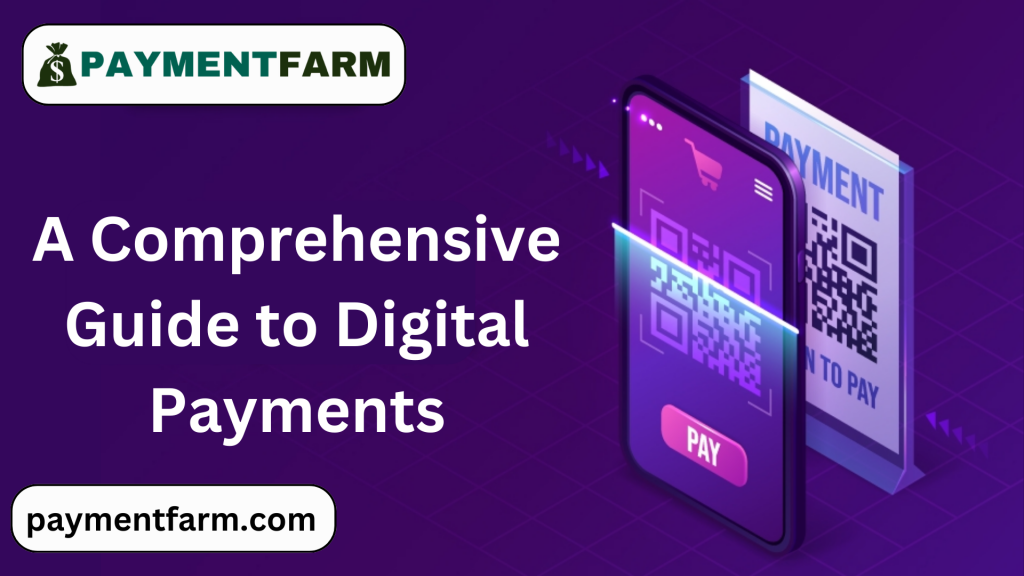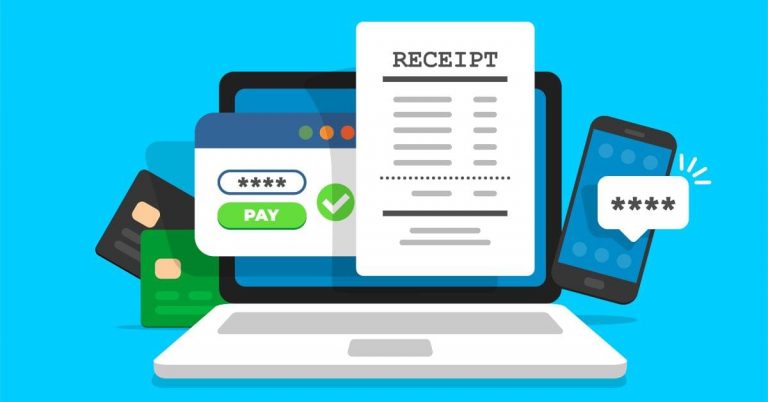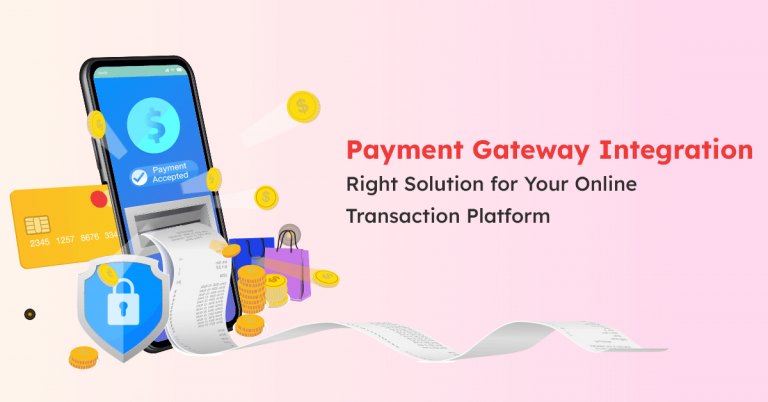Digital payments are no longer an afterthought in trading today but a necessity for firms of any size if they are to grow. It is a necessity for any brand to enhance consumer satisfaction and operational efficiency in a physical as well as a virtual business environment.This e-book has explored the working of online payment methods, the benefits of electronic payment to customers and businesses alike, and how to implement an electronic method of payment successfully.

What are digital payments?
Financial transactions carried out through digital channels without the use of real currency are referred to as digital payments, electronic payments, or e-payments. From online payment gateways to mobile wallets, they enable smooth transactions across several platforms, providing speed and convenience for both businesses and consumers.
What kinds of online payment methods are there?
Any method of using electronic payment tools to move money or electronic money from one party to another qualifies as a digital transaction. Common types of electronic payments are usually categorized under this:
- Online electronic payment systems: Wire transfers, electronic checks, and electronic bank transfers
- Mobile payments: Venmo, Zelle, PayPal, etc. Mobile wallets, also known as digital wallets or e-wallets, include Samsung Pay, Apple Pay, and Google Pay.
- Digital cards: A credit, debit, or prepaid card that is sent straight to a consumer’s mobile device or E wallet by a banking institution
- Contactless payments: This broad category can include mobile wallets that use magnetic security transmission (MST) technology as well as contactless credit, debit, and prepaid cards utilizing near-field communication (NFC) technology.
- Cryptocurrency payments: Blockchain is the most widely used distributed ledger technology that enables safe online transactions.
- Peer-to-peer payments: Peer-to-peer payments, also known as person-to-person payments, are a form of mobile banking that involves digital payments between two people. One person’s bank account, checking account, credit or debit card, or payment app sends the money straight to another person’s bank account or app.
Best payment gateways for digital payment processing
Payment providers for electronic system of payment are listed below:
- Authorize.net
- 2Checkout
- Square
- PayPal
- Stripe
- Helcim
- Shopify
- Amazon Pay
- Apple Pay
- Adyen
Security of application for online payments
Secure online payments transaction is done by this electronic system of payment. Payment security step of this method are given below:

- The use of encryption: When processing digital payments, encryption is essential for protecting sensitive data since it jumbles the data and renders it unintelligible in the event that it is intercepted. The UK Payment Card Industry Data Security Standard requires encryption requirements to keep information about a cardholder safe and ensure compliance, therefore maintaining trust between consumers.
- Tokenization: Tokenization provides increased security of electronic payment systems by substituting card data with an encrypted and unique identifier. It keeps a business safe from chances of identity theft and breaches through card data tokenized at the point of input with those tokens safely kept and not the raw card data. This also supports abidance to GDPR, keeping all personal data and information associated with payment safely processed and protected.
- Authentication of two factors: SCA is emphasized under the PSD2 updated directive of UK to decrease fraud risks of digital payments. Additional procedures of verification entail two-factor authentication, thereby providing security through electronic payments. It is typically the integration of something that the user already owns—such as a mobile device or a card reader and something that he knows: password or PIN.
Issues and things to think about with electronic payments
- Online fraud prevention:The risk of fraud is one of the main issues with electronic payments. As the number and complexity of digital transactions increase, so do the strategies used by cybercriminals to take advantage of weaknesses. Therefore, in order to protect against unauthorized transactions and data breaches, businesses need to invest in strong fraud detection and prevention procedures. It’s crucial to inform staff members and clients about phishing schemes, identity theft, and other fraud strategies related to digital payments in addition to putting fraud monitoring tools in place to examine transaction patterns and identify irregularities instantly.
- Adherence to regulations: Businesses that use digital payment systems must adhere to strict regulatory standards. To safeguard consumer rights and guarantee data privacy, the UK requires adherence to laws like PSD2 and GDPR. Data security, transaction transparency, and customer verification are all subject to these regulations. In addition to exposing companies to legal repercussions, non-compliance erodes credibility and customer trust.
- Problems with technology: To avoid outages and compatibility problems that could interfere with the electronic payment process, businesses need to make investments in strong IT infrastructure and proactive management. As electronic forms of payment continue to develop and grow, this is especially crucial. Maintaining current software, doing frequent testing, keeping an eye on system performance, and working with payment service providers (PSPs) are all crucial steps in reducing technical problems that could affect operations.
Contactless payments
In digital payments, contactless payments—which make use of technologies like Radio Frequency Identification (RFID) and Near Field Communication (NFC)—are becoming more and more common. Consumers can pay quickly and easily by just tapping their cards or smartphones into a card reader. Because contactless payments are more hygienic and eliminate the need for physical touch and handling banknotes, the COVID-19 pandemic has spurred their use.
- Artificial Intelligence Integration: Modern payment platforms are progressively incorporating artificial intelligence (AI) to improve operational efficiency, security, and user experience. AI can help with fraud detection, predictive analytics, and personalized services. Machine learning algorithms, for example, can examine transaction patterns to identify and stop fraudulent activity, greatly enhancing the security of electronic payments.
- Biometric Verification: Verifying a person’s identity using their distinct biological or behavioral traits—such as fingerprints, facial patterns, voice, or retinal scans—is known as biometric authentication. This technology, which offers a higher level of protection than conventional techniques like passwords and PINs, is being integrated into digital payment systems. By adding an extra layer of security, connecting transactions to biometric information makes it more difficult for fraudsters to obtain unauthorized access.
Advantages of digital payments
With their many advantages that meet the demands of the contemporary, technologically connected world, digital payments are revolutionizing the banking sector. They are a good option for both individuals and enterprises since they combine cost-effectiveness, efficiency, convenience, and cutting-edge security features. Let’s examine how digital currency payments maximize the transaction experience by utilizing these advantages.
- Accessibility and Convenience: The use of electronic payments make transactions easier and more convenient by doing away with the need for actual cash. With only a few clicks, customers may start transactions at any time, from any location, thanks to services like internet banking, mobile wallets, and payment apps. This accessibility also applies to international transactions, getting around the geographical restrictions that have hitherto made money transfers difficult.
- Quickness and Effectiveness: The quickness and effectiveness of electronic payments are two of their main benefits. When opposed to conventional techniques, transactions, whether local or international, can be finished in a matter of seconds, greatly cutting down on time. Additionally, real-time transaction monitoring, rapid payment confirmations, and automatic repeating payments improve productivity and simplify financial management.
- Economicalness: In addition, electronic withdrawals may be less expensive than conventional ones. They assist in lowering the operating expenses associated with managing, keeping, and shipping actual currency. Additionally, a lot of digital payment companies provide benefits like incentives, discounts, and cashback, which over time can result in significant consumer savings.
- Improved Security Protocols: An essential component of electronic financial transactions is security. They use cutting-edge security procedures and encryption technology to shield transaction data from possible dangers. Additional security layers are added by features like tokenization, biometric identification, and two-factor authentication, which guarantee the safe and secure processing of transactions.
Disadvantages of digital payments
Online payment methods have many advantages, but they also come with risks and difficulties. These include challenges with technology infrastructure, the possibility of fraudulent activity, and cybersecurity concerns. For electronic payment systems to operate securely and effectively, each of these areas has particular challenges that need to be overcome.
- Issues with Cybersecurity: When it comes to digital payments, cybersecurity is a major problem. Cybercriminals find these systems appealing because they send sensitive data, such as bank account information, credit card information, and personal identity information. The need for strong cybersecurity procedures and controls is highlighted by the rise in malware assaults, phishing scams, and data breaches in the field of digital payments.
- Fraudulent Practices: Additionally, digital payments may be vulnerable to several types of fraud. Identity theft, credit card fraud, and unauthorized transactions are a few examples of this. According to a Nilson analysis, the expected global losses from card theft in 2019 were $28.65 billion, underscoring the seriousness of the problem.
- Infrastructure for Technology: The availability of dependable and cutting-edge technological infrastructure is critical to the successful deployment and operation of digital payments. High-speed internet access, scalable and safe digital platforms, and advanced encryption technologies are necessary for this. However, the broad acceptance and use of digital payments might become a major barrier in areas where such infrastructure is either nonexistent or insufficient.
Online Payment integration solutions

- Make that the API or plugin from your preferred payment provider works with your current IT infrastructure and e-commerce platform before integrating it into your website, mobile app, or point-of-sale system.
- Verify adherence to legal requirements like
- Put strong security measures in place, like two-factor authentication, tokenization, and encryption.
- To find and fix any integration problems, thoroughly test the functioning of electronic payment processing.
- Introduce your new electronic payment system.
To sum up
Such indispensible usage of digital payments has offered convenience and speed for the consumer while having improved security for business entities involved in modern commerce. From online payment systems to mobile wallets, contactless payments, to cryptocurrencies, each type of digital payment has frictionless transactions on any other platform. While these smooth flows of operational processes through various means of digital payment contribute positively, requirements for robust cybersecurity have also been established, which prevents fraud or any form of data violation. For businesses, this means securing compliance with regulations, implementing strong authentication and encryption practices, and keeping IT infrastructure up to date with evolving threats. Overall, digital payments foster a more efficient, cost-effective, and globalized marketplace, though with responsibilities tied to security and regulatory adherence.
Faqs
What are digital payments?
Financial transactions carried out through digital channels without the use of real currency are referred to as digital payments, electronic payments, or e-payments. From online payment gateways to mobile wallets, they enable smooth transactions across several platforms, providing speed and convenience for both businesses and consumers.
What is Consumer behavior towards digital payments?
Every electronic payment transaction is carried out online. It is a quick and practical method of payment. The study of how individuals, groups, or organizations choose, purchase, utilize, and discard concepts, products, and services to fulfill their needs and desires is known as consumer behavior.
Explain Digital wallets vs traditional wallets?
Since mobile payments are fully tokenized and encrypted, and since the digital wallet does not keep your actual card or account data, it is actually more safe than traditional cards.
Do any digital payment processing fees?
Depending on the platform and the type of transaction, digital payment price structures vary greatly. While some platforms provide free services, others could impose a minor transaction fee. To prevent unpleasant surprises, customers should examine the charge schedules of the digital payment systems they have selected.
How do digital payments help with international transactions?
Digital payments eliminate geographical barriers, allowing for fast and efficient international money transfers, typically at lower costs than traditional bank transfers or currency exchanges.
What are the risks of online fraud in digital payments?
Digital payments can be susceptible to risks such as phishing, identity theft, and unauthorized transactions. Strong fraud detection tools and consumer awareness are key to preventing fraud.
What is biometric authentication in digital payments?
Biometric authentication uses a person’s unique biological traits—such as fingerprints, facial recognition, or retina scans—to verify identity and authorize transactions, adding a layer of security.
Are there any fees associated with digital payment transactions?
Fees vary depending on the payment platform and transaction type. Some platforms charge transaction fees, while others offer free services. It’s important to check the fee structure before making payments.
What is the role of payment gateways in digital payment processing?
Payment gateways act as intermediaries, securely transmitting payment information between the customer, merchant, and payment processor, enabling smooth and secure transactions.
What is two-factor authentication (2FA) in digital payments?
Two-factor authentication (2FA) requires users to provide two forms of identification—such as a password and a mobile device verification—before completing a transaction, enhancing security.
